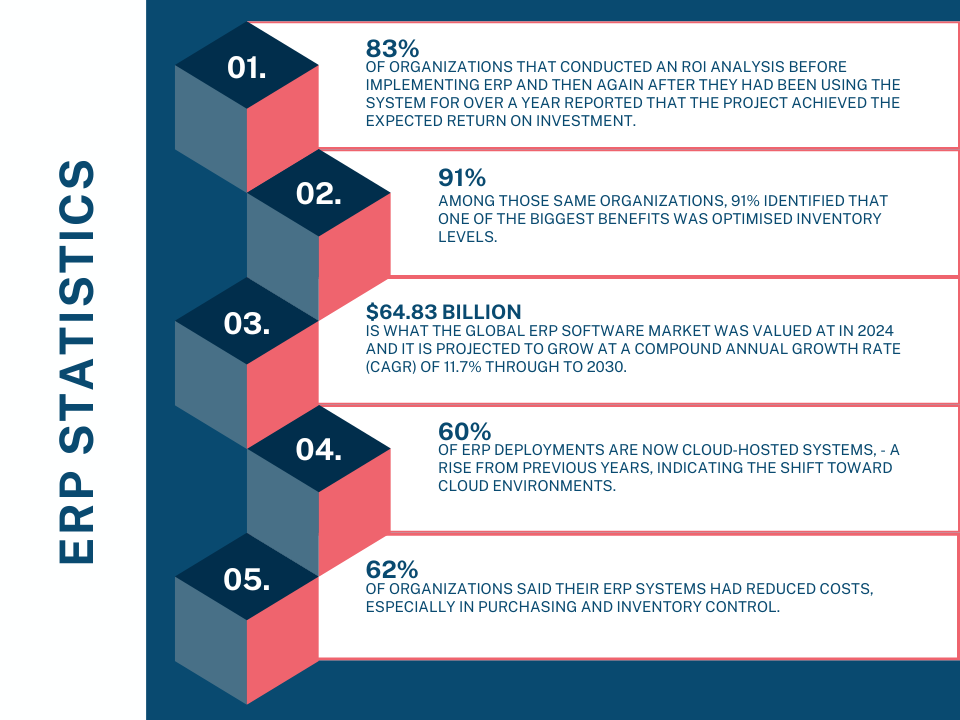Running a modern business means managing a growing number of processes, from finance and human resources to inventory, production, and customer relationships. When these processes operate in isolation, inefficiencies, errors, and miscommunication can slow growth and impact profitability.
This is where Enterprise Resource Planning, or ERP, comes in.
ERP is more than just software. It is a system that centralizes business operations, connecting people, data, and processes on a single platform. By integrating multiple functions into one unified system, ERP helps businesses streamline workflows, gain real-time insights, and make smarter decisions.
In this article, we will break down what ERP is, explore the different types of ERP systems and applications, and examine how businesses can leverage ERP software to improve efficiency, collaboration, and overall performance.
What is Enterprise Resource Planning?
Enterprise Resource Planning, or ERP, is a comprehensive software system that enables an organization to manage and integrate its core business functions through a unified platform.
These functions often include finance, human resources, supply chain and manufacturing, sales and customer service.
Rather than operating departmental silos with separate tools and disconnected data, ERP brings all these functions onto a shared system so that information flows across the organization, enabling alignment, transparency and data‑driven decision-making.
Below are compelling statistics that show how ERP implementation and use can materially impact business performance.
- A recent survey found that 83% of organizations that conducted an ROI analysis before implementing ERP and then again after they had been using the system for over a year reported that the project achieved the expected return on investment.
- Among those same organizations, 91% identified that one of the biggest benefits was optimized inventory levels.
- The global ERP software market was valued at approximately US$64.83 billion in 2024 and is projected to grow at a compound annual growth rate (CAGR) of 11.7% through to 2030.
- Around 60% of live ERP deployments are now cloud‑hosted systems, a rise from previous years, indicating the shift toward cloud environments.
- In one report, 62% of organizations said their ERP systems had reduced costs, especially in purchasing and inventory control.

Benefits of Enterprise Resource Planning Software and Systems
Enterprise Resource Planning systems and software offer significant advantages for organizations of all sizes. The following are some of the most practical benefits of implementing ERP software.
- Streamlined operations across departments: automates repetitive tasks such as order processing, inventory tracking, and invoice generation. Reduces errors, speeds up workflows, and ensures consistency across teams.
- Enhanced data visibility and reporting: consolidates data from all business functions into real-time dashboards and comprehensive reports. Enables managers to monitor trends, performance metrics, and potential risks for informed decision-making.
- Improved collaboration between teams: shared access to the same information fosters coordination, accountability, and alignment toward shared organizational goals. Cross-functional teams can execute projects efficiently and respond quickly to operational challenges.
- Support for compliance and scalability: structured processes, audit trails, and accurate recordkeeping help organizations meet regulatory requirements. Scalable architectures allow new users, modules, or locations to be added without disrupting operations.
- Increased efficiency: reduces manual work by automating repetitive processes, freeing teams to focus on strategic initiatives.
- Enhanced user experience: modern interfaces and dashboards simplify complex processes, making it easier for employees to navigate the system and complete tasks efficiently.
- Improved accessibility: mobile-friendly access allows employees to work from anywhere, increasing productivity and operational continuity.
- Better decision-making: provides real-time operational insights that allow organizations to make data-driven decisions and identify improvement opportunities.
- Cost-effectiveness: reduces infrastructure, training, and implementation costs, particularly when specialized apps are used.
Enterprise Resource Planning Integration
Enterprise Resource Planning systems become even more powerful when integrated with other business systems, creating a connected environment where information flows freely between applications.
ERP integration links the core ERP platform with tools such as Customer Relationship Management (CRM) systems, accounting software, and specialized third-party applications. This ensures that data from every department, from sales to finance to operations, is synchronized and accessible across platforms.
This type of integration unlocks benefits that are unique to a connected ecosystem, going beyond what ERP systems alone can deliver:
- 360-degree customer visibility: by connecting ERP with CRM systems, organizations can see the full lifecycle of a customer in one place. This includes purchase history, support interactions, payment status, and product usage patterns. This complete view enables personalized service, more accurate customer segmentation, and targeted marketing campaigns that would be impossible with disconnected systems.
- Automatic financial reconciliation: ERP integration with accounting software allows transactions to flow automatically between operational and financial systems. Payments, refunds, and invoicing are updated in real time, reducing reconciliation errors and accelerating month-end closing processes. Finance teams gain confidence that their data reflects actual business activity without manual intervention.
- Cross-platform compliance and audit readiness: when ERP is integrated with specialized compliance or regulatory tools, businesses can track rules, certifications, or approvals across multiple systems automatically. For instance, data from production, sales, and finance can be combined to generate comprehensive audit reports instantly, reducing manual effort and the risk of non-compliance.
- Coordinated multi-system workflows: integration allows processes to span multiple applications automatically. For example, when a new customer order is received through the CRM, the ERP can update inventory, trigger accounting entries, and notify shipping or service teams. These workflows reduce delays and ensure that all systems act in coordination without human oversight.
Modern ERP Trends: Mobile and Cloud-Based Applications
Enterprise Resource Planning systems have evolved to meet the diverse needs of modern businesses. Today, companies can choose between cloud-based ERP systems and on-premise ERP systems, and they can enhance either type with mobile ERP applications for increased flexibility and accessibility.
Cloud-Based ERP Systems
Cloud ERP systems are hosted on external servers and accessed through the Internet. This setup allows businesses to scale easily as they grow, adding new users, departments, or features without significant investments in hardware or IT infrastructure. Updates, backups, and security measures are handled by the service provider, reducing the maintenance burden on internal IT teams.
The cloud also enables employees to access the ERP system from any location with an Internet connection. This makes collaboration across multiple offices or remote teams much easier. Companies benefit from real-time data updates, centralized information, and the ability to make fast, informed decisions without being tied to a physical office.
Cloud ERP is especially well-suited for organizations with distributed teams, rapid growth, or limited IT resources.
On-Premise ERP Systems
On-premise ERP systems are installed and managed on a company’s own servers. This approach provides greater control over data and system customization. Businesses with strict compliance requirements or highly sensitive information often prefer on-premise ERP because it allows them to manage security and regulatory oversight internally.
However, on-premise systems require significant upfront investment in hardware and ongoing maintenance from IT teams. Accessibility is more limited, as employees typically need to connect through internal networks or VPNs to access the system. Scaling an on-premise ERP can also be more complex, as adding new users or locations often requires additional infrastructure and configuration.
Mobile ERP Applications
Mobile ERP applications act as a front-end interface for ERP systems, enabling employees to access critical functions from smartphones or tablets. Mobile ERP can connect to either cloud or on-premise systems, providing flexibility based on the company’s infrastructure.
Cloud mobile ERP offers real-time updates, instant data synchronization, and full accessibility from anywhere, making it ideal for field teams, sales representatives, or remote employees.
Non-cloud mobile ERP connects to internal servers via secure networks or VPNs. While it offers data control and compliance advantages, it comes with limitations such as restricted access, higher maintenance, scalability challenges, and slower data synchronization.
Adding a mobile ERP application is particularly valuable when teams need to update information on the go, respond quickly to operational changes, or collaborate in real time across locations. For many organizations, mobile ERP becomes the bridge between efficiency and accessibility, allowing businesses to extend the power of their ERP systems beyond the office floor.
Best Practices for a Successful Enterprise Resource Planning Implementation
Implementing an Enterprise Resource Planning system is a significant undertaking for any organization. A successful implementation requires careful planning, coordination across departments, and a clear understanding of the company’s goals. Following best practices can reduce risks, improve adoption, and ensure the ERP system delivers the expected business value.
Conducting a Needs Assessment
Before selecting an ERP system, organizations should conduct a thorough needs assessment. This involves identifying the key business processes that need to be integrated, understanding the unique requirements of each department, and defining the desired outcomes of the ERP implementation.
By clearly understanding what the organization needs, leaders can choose software that aligns with both current operations and future growth.
A detailed assessment also helps avoid purchasing unnecessary features or investing in a solution that is not fully compatible with existing workflows.
Phased Implementation vs Big-Bang Approach
ERP implementations can follow either a phased approach, where modules are introduced gradually, or a big-bang approach, where the entire system goes live at once.
A phased implementation allows organizations to focus on one module at a time, test processes, and make adjustments before expanding to other areas. This method reduces disruption and allows for smoother adoption.
The big-bang approach can be faster but carries higher risk, as any issues affect the entire organization immediately.
Choosing the right strategy depends on the company’s size, complexity, and tolerance for risk.
Employee Training and Change Management
Even the best ERP system will fail if employees are not prepared to use it effectively. Comprehensive training ensures that users understand new processes, tools, and workflows.
Change management programs help employees adapt to shifts in responsibilities, communication, and reporting.
Engaging employees early, providing clear documentation, and offering ongoing support fosters buy-in and reduces resistance, which is critical to achieving full system adoption.
Continuous Monitoring and Optimization
ERP implementation is not a one-time project but an ongoing process. Organizations should continuously monitor system performance, collect user feedback, and identify areas for improvement.
Regular updates, process adjustments, and optimization efforts ensure that the ERP system remains aligned with evolving business needs. By treating ERP as a dynamic tool rather than a static solution, companies can maximize efficiency, accuracy, and return on investment over time.
Custom ERP Application Development Services
While off-the-shelf ERP software can address many standard business needs, it often falls short for organizations with unique workflows or industry-specific requirements. This is where custom ERP application development services become invaluable. Custom solutions allow companies to design an enterprise resource planning application tailored precisely to their processes, ensuring that every function, report, and integration aligns with business objectives.
Tailored ERP solutions offer several key benefits. They streamline unique workflows, automate repetitive tasks, and enable seamless integration with existing tools or third-party applications. By matching the system to actual business operations rather than forcing processes to fit the software, companies achieve higher efficiency, improved data accuracy, and greater operational transparency.
AppIt specializes in ERP application development, guiding clients through the full process from discovery and requirements gathering to development, testing, and deployment. Our team ensures that every enterprise resource planning application is scalable, secure, and built to support both current needs and future growth.
For businesses looking to go beyond standard ERP software and implement a system that truly fits their organization, AppIt provides the expertise and experience to deliver a solution that drives results.
Contact AppIt today to discuss your custom ERP development needs and unlock the full potential of your business operations.







